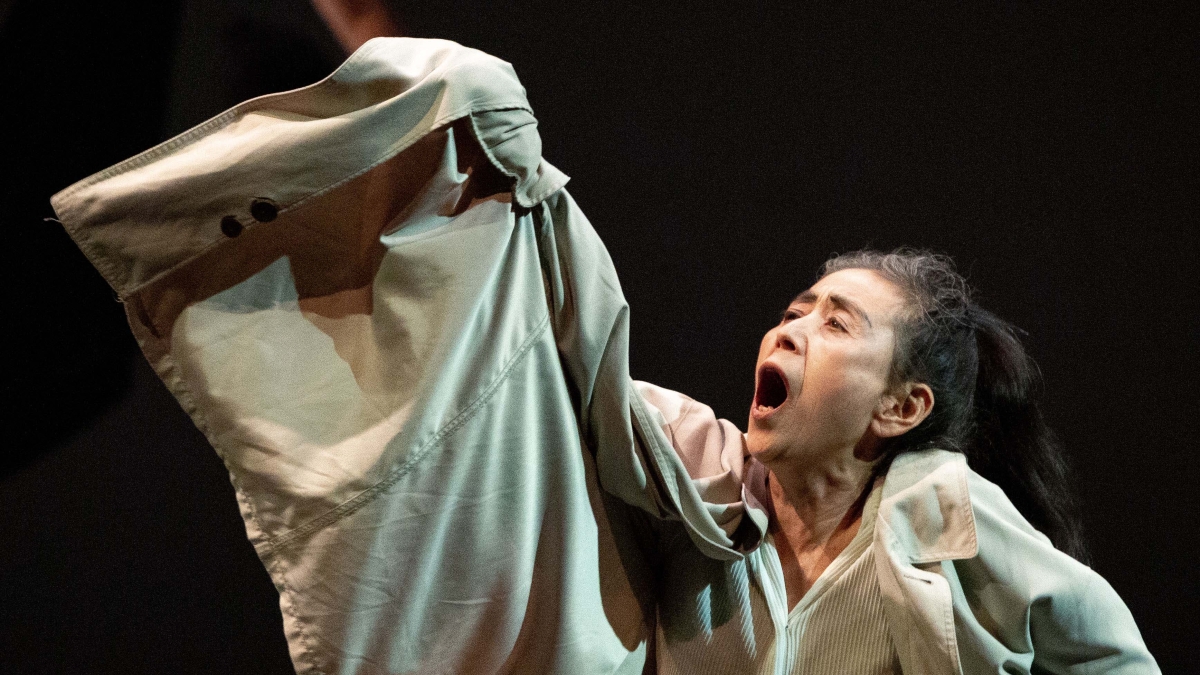Eiko Otake returns to ASU Gammage with 'The Duet Project' Sept. 10

Eiko Otake performs an interpretive dance as part of a duet in her series "The Duet Project."
In "The Duet Project," movement-based interdisciplinary artist Eiko Otake returns to ASU Gammage with a series of duets between her and a diverse group of collaborating artists, living and dead.
The collaborators in this performance come from different places, times and artistic disciplines, and the duets will investigate how two artists collide and express what they care about.
Tickets are on sale now for "The Duet Project," premiering on Saturday, Sept. 10, and can be purchased at asugammage.com/shows-events/duet-project.
Otake recently spoke with ASU News about her upcoming performance.
Question: What inspired you to create "The Duet Project," and what can audiences expect at the show?
Answer: After working with (musical artist Takashi Koma Otake) for more than 40 years and following our three-year "Retrospective Project," I began my solo project in 2014. I started with working in irradiated Fukushima, Japan, after the 2011 nuclear meltdowns. Since 2014, I have performed my solo in 78 places. My solo performances were my conversations with different places — a train station, a library, a senior citizen home, a closed restaurant, an artist's studio, etc. Meanwhile, I learned that people really did not know who I was outside of the context of Eiko & Koma, so I began a series of talking duets with many movement/dance artists I admire. Combining these two threads, I conceived this — "The Duet Project."
In "The Duet Project," I work with multiple collaborators, but one-by-one. They are from different generations, disciplines and concerns. Some started as strangers, and others were friends. And there are dead people among my collaborators. I get to learn from each duet — learn about someone else, about myself, about different methods of encountering each other and working together. Then, each performance is based on where it will be performed and who is available and who wants to work within this particular place/community. The themes of grief and friendship have been some of the main elements. This is not dance-dance, but it is not theater-theater. This evening is multi-dimensional and interdisciplinary. Audience members see the evening with different elements, some closer to them than others. In all of them is our desire to be closer to other humans and how we seek to intersect with others.
Q: What do you hope the audience takes away from the performance?
A: My main purpose is to provide a time and place where people can be together, to be inspired or inspiring, and to be thoughtful. I do not entertain, and I do not make a theater production that can just travel as one piece, always the same. But I am process-oriented. I do care that each performance is well-considered and elaborated as much as time allows. I want audience members, each of them, to go home thinking, "Wow, it was good that I decided to come to see this." I want to provide rich layers within an event in which audience members notice different things, and they can weave these elements together for themselves. Also, we tend to provide visual and kinesthetic content that uncovers topics such as death and mourning, which is not as widely acknowledged in U.S. culture. I hope others see the important details that are actually entries into the work and represent the core of the evening, but these details are left to each person to notice. My job is to provide many of these details.
Q: What was the process for creating the show?
A: I sit in the place, open every door possible, find resources, imagine and try. I like to have some people attend the rehearsals so I can also hear their thoughts.
Q: What do you look forward to most about performing in Tempe?
A: Sharing what I do with people, what my collaborators do, hearing audiences' thoughts and creating new material. Maybe the audiences who saw Eiko and Koma in the past would like to see this evening to find a different Eiko thinking and moving in the same Eiko. I performed here several times over many years. I hope to reach the people who saw me before as well as new people who are seeing me for the first time.
Q: Do you have any advice for aspiring movement-based artists?
A: Work, be a citizen of the world and be a contributor to communities. Make friends, answer your questions in your own way. Be OK with not having an answer.
More Arts, humanities and education

Upcoming exhibition brings experimental art and more to the West Valley campus
Ask Tra Bouscaren how he got into art and his answer is simple.“Art saved my life when I was 19,” he says. “I was in a…

ASU professor, alum named Yamaha '40 Under 40' outstanding music educators
A music career conference that connects college students with such industry leaders as Timbaland. A K–12 program that…

ASU's Poitier Film School to host master classes, screening series with visionary filmmakers
Rodrigo Reyes, the acclaimed Mexican American filmmaker and Guggenheim Fellow whose 2022 documentary “Sansón and Me” won the Best…

